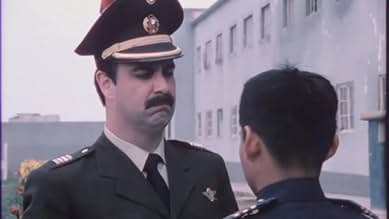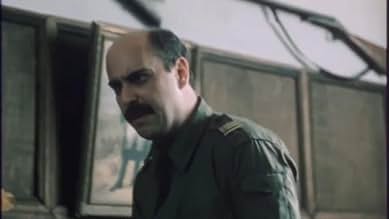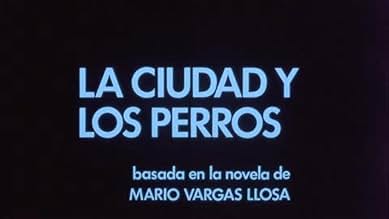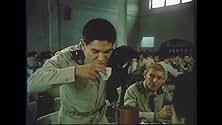Agrega una trama en tu idiomaFour angry cadets form an inner circle to beat the system, boredom and the stifling confinement of the military academy, sparking a chain of events that begins with a robbery and leads to mu... Leer todoFour angry cadets form an inner circle to beat the system, boredom and the stifling confinement of the military academy, sparking a chain of events that begins with a robbery and leads to murder.Four angry cadets form an inner circle to beat the system, boredom and the stifling confinement of the military academy, sparking a chain of events that begins with a robbery and leads to murder.
- Dirección
- Guionistas
- Elenco
- Premios
- 2 premios ganados en total
Opiniones destacadas
I liked the movie but if you read the Mario Vargas Llosa's novel it's even better. The movie is as good as La boca del lobo. The acting is good: Alberto, el Esclavo, Jaguar, and specially Gustavo Bueno as Teniente Gamboa. A classic of peruvian filmography.
10dantt777
One of the best Peruvian movies that I have ever watch, and pretty close to the book too. In this movie you can watch one of Peru's best actors in the last 30 years, Gustavo Bueno, who was the doctor in Lima in the Motorcycle Diaries. His motto to the cadets, "what are you laughing at? do you want a naked picture of me? is a classic. You can also see a lot of the racial, ethnic and class issues affecting Peru in those years, the large Indian immigration to Lima, and other cultural characteristics of the region and the country. Leoncio Prado is a real school in Peru. To a ceertain extent, things have not change much in Peru since then, so it is a ninteresting interpretation of the country's soul.
It´s the best movie directed by Francisco Lombardi . The relation of an adolescent called "The Poet" with a group of bad and fool teenagers that generally studying in a military school converts him like a hero when finally fights against the "gang " leader called Jaguar , discovering that he murdered his best friend called "The Slave" a passive and timid boy . This movie shows the most close realism of a peruvian and latin-american problem.
The film may have a low budget, a non-existent soundtrack and mediocre acting. Yet the story is so powerful -the movie is loyal to Vargas Llosa's classic novel-, so close to the truth and so well told, it is capable to kick you in the groin.
While I agree with many of the comments already made in terms of the low-to-medium quality of this film's production, its incredible story more than makes up for it.
I used this film in a course I taught twice on Masculinity in Latin American Literature -instead of reading the novel the movie adapts, because it allowed me to include more texts in less time. If you can, read the book, but beware: Vargas Llosa's are usually 500+ page novels.
The story ends up being a virtual textbook on male homosocial structures and systems. It spoke loud and clear to all my students on the key issues at play in relationships of power amongst males. All the guys could relate to the pressures of conformity the movie represents. But male and female alike saw the dichotomies and subtleties present in the strange ways in which young men socialize and force each other to fit into orthodox male culture, or else. Though the context is a bit extreme, a military academy is certainly a more restricted and anxiety-producing environment than the average school, it outlines all the roles and behaviors imposed upon young men by the culture at large -a male-oriented and dominated society.
Despite its limitations as a film, the story stands strong and true. Unfortunately, it remains contemporary in many ways. Not one student felt it was irrelevant; instead they found interesting the metaphoric use of "dog" to signify the barbaric qualities of the military/male systems represented. "Dog" is a cultural signifier they hear in popular US music a-plenty and its use in the film added a new dimension to their understanding of its meaning.
Vargas Llosa's semi-autobiographical tale of male isolation and survival is poignant and deep. I recommend it to anyone who is interested in themes related to the life of boys.
I used this film in a course I taught twice on Masculinity in Latin American Literature -instead of reading the novel the movie adapts, because it allowed me to include more texts in less time. If you can, read the book, but beware: Vargas Llosa's are usually 500+ page novels.
The story ends up being a virtual textbook on male homosocial structures and systems. It spoke loud and clear to all my students on the key issues at play in relationships of power amongst males. All the guys could relate to the pressures of conformity the movie represents. But male and female alike saw the dichotomies and subtleties present in the strange ways in which young men socialize and force each other to fit into orthodox male culture, or else. Though the context is a bit extreme, a military academy is certainly a more restricted and anxiety-producing environment than the average school, it outlines all the roles and behaviors imposed upon young men by the culture at large -a male-oriented and dominated society.
Despite its limitations as a film, the story stands strong and true. Unfortunately, it remains contemporary in many ways. Not one student felt it was irrelevant; instead they found interesting the metaphoric use of "dog" to signify the barbaric qualities of the military/male systems represented. "Dog" is a cultural signifier they hear in popular US music a-plenty and its use in the film added a new dimension to their understanding of its meaning.
Vargas Llosa's semi-autobiographical tale of male isolation and survival is poignant and deep. I recommend it to anyone who is interested in themes related to the life of boys.
¿Sabías que…?
- TriviaThe film was shot in a nearby een jail, the building were very alike.
- ErroresWhen Cadet Alberto Fernández ("The Poet") is giving evidence to the Colonel, a boom mic is visible twice.
- Citas
Lt. Gamboa: Why are you staring at me cadet? You want my picture on my bare ass or what?
- ConexionesReferences Scum más allá de la degradación (1979)
Selecciones populares
Inicia sesión para calificar y agrega a la lista de videos para obtener recomendaciones personalizadas
Detalles
Taquilla
- Presupuesto
- USD 225,000 (estimado)
Contribuir a esta página
Sugiere una edición o agrega el contenido que falta

Principales brechas de datos
By what name was La ciudad y los perros (1985) officially released in Canada in English?
Responda
















